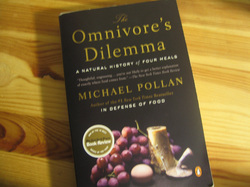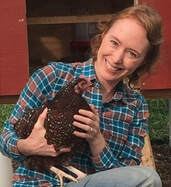
But The Omnivore's Dilemma was the best of the best - smart, interesting, thoughtful, and well-researched, plus a joy to read! Funny at times, poignant and sad at others, cleverly written, and with a poetic slant you don't often find in modern non-fiction - particularly about the food system! I thoroughly enjoyed it, although some parts more than others.
Here is a quick rundown of the book's four sections, and my observations on each - plus why I recommend reading it - to...well...anyone who eats food!!
As I discussed at length in previous blog posts, the first part of the book is about the history of corn, and it's impact on the world's food systems. You would think this would be boring, but I actually found it fascinating! Pollan's entertaining writing style has a lot to do with that, of course, but it also was extremely eye-opening: I had no idea the extent to which corn is the backbone of our food processing industry, and the entire American food chain. If you don't think you eat that much corn - think again - particularly after you read the ingredients of a chicken nugget....
Pollan starts with the history of the corn plant, and follows it through the American cornfield, the processing plant, and the meat industry, until it ends up on his plate - or in his McDonald's take-out bag to be precise. The end of this section hauntingly and accurately describes the feeling one gets from eating fast food - a feeling that has led to obesity for thousands of people....
Meal #2: Industrial/Big Organic
For Pollan's second meal, he explores the industrial or "big" organic food system - which is surprisingly similar to the conventional chemical-based system. Don't assume that your organic chickens are treated much better than conventionally raised chickens, unless labeling (or the farmer) specifically tells you how they were raised. The main differences here are that some animals may have slightly more space than their conventional counterparts (although not necessarily), and they are fed organic feed - which doesn't necessarily mean it's all that much better for the animal. (For example, most animals were not meant to eat corn in large quantities, and doing so - especially for cattle - can lead to severe health problems.)
Large-scale organic farming may not use chemical pesticides to grow crops, but in some ways (although not all), it is also fairly destructive of the environment - and is certainly not done using natural, holistically balanced or sustainable farming methods in most cases.
That said, there certainly good things to be said for not adding billions of pounds of pesticides and herbicides to the environment every year, as well as avoiding GMO's (not allowed in organics). If we're going to continue to use and support today's large-scale industrial farming methods, organics may be the best we can hope for.
 Pigs on pasture at Polyface Farms.
Pigs on pasture at Polyface Farms. This was probably my favorite section of the book. Having had some familiarity already with Joel Salatin's grass-farming methods, and the shining example of Polyface Farms, I was especially eager to dive into the details revealed here regarding his operation. And Pollan did not disappoint. I wanted to disappear into the pages - emerging amid the grassy rolling hills of Polyface, and spend the day helping move chicken pens and cow fences.
The holistic, integrated systems used by Polyface Farms to raise food animals happily expressing their inherent natures in the environment in which they were designed to live, is such an inspiring model to aspire to emulate.
It is so far from the industrial food system model, it's hard to imagine that each can produce the same types of food - although obviously not the same quality! If anyone has doubts as to whether it is possible to raise food animals in an ethical and sustainable manner, I highly encourage you to read about the example of Polyface Farms.
I felt so happy to be able to say that the majority of the food I eat is raised in a similar manner. And if it wasn't, it would be after reading this book! I could have stood to read an entire book just on this section, and maybe that's why the final section of the book was not as interesting to me....
Meal #4: Foraging - The Forest
I had kind of thought this would be one of my favorite parts of the book, so I was surprised that it actually didn't interest me all that much. Perhaps because, as Pollan himself says, it's not a sustainable or realistic method of eating in today's modern, developed world....
Having grown up on a farm in the Ozark mountains, I am quite familiar with things like mushroom hunting, growing food, and even hunting for wild meat to some extent. But although Pollan's adventures were as usual, well-told with humor and humility, I wasn't all that engaged. Despite a familiarity with the topic, I just didn't feel inspired. Following the section on organic and grass farmed foods, which actually ARE sustainable and ethical, and can be a viable means of eating in today's world, this throw-back to the hunting and foraging days of humanity seemed to be out of place and uninspiring.
But regardless of what was, for me, a somewhat lackluster ending, this book is one that I will forever remember, and probably will read (at least in part) multiple times. If I already wasn't on a path to better eating, I would be after reading this book, and I can see how it could potentially be life-changing for a lot of Americans.
I honestly don't see how anyone could continue eating blindly through the industrial food system after reading this book. You will learn things that will forever change the way you look at food, and how you approach everything from eating out, to shopping, to preparing your meals, to teaching your kids about where food comes from. The changes may not come all at once, and that's fine. Gradual is probably best, if you are a typical American eater. (For tips and guidance throughout the transition, be sure to keep an eye on this blog as I will serve as your brave, trailblazing pioneer woman!) :-)
I encourage every man, woman, and young person to read this book. It may or may not forever change your life, but it will definitely forever change the way you eat - and based on the declining health of our nation - that's a really good thing.
You can find The Omnivore's Dilemma on Amazon.com, and in most bookstores.



 RSS Feed
RSS Feed